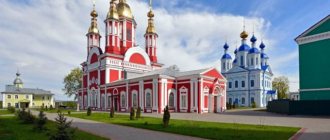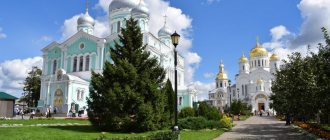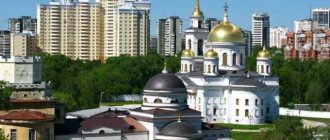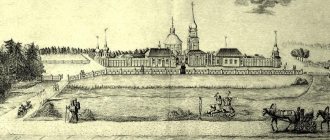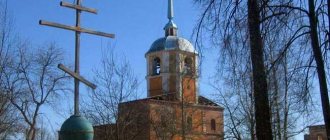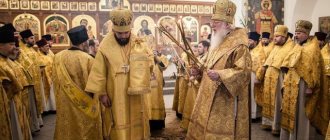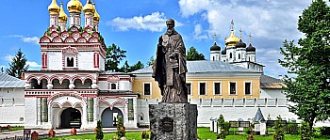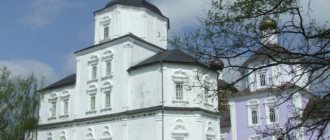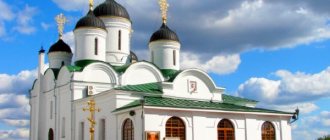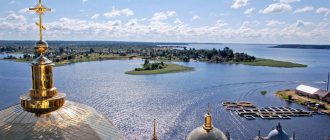The Trifonov Monastery is located on the river bank in the historical center of Kirov. The Assumption Cathedral of the monastery is the oldest building in the city and the oldest Vyatka Orthodox church built of stone, which was lucky enough to survive to this day. Now the cathedral has the status of a federal architectural monument with a three-century history.
The Trifonov Monastery in Kirov arose thanks to an amazing person - the monk of the Pyskorsky Monastery Trifon; in 1580 he appeared in the city and intended to organize a monastery here.
The townspeople supported Tryphon's idea, and he went to Moscow with a petition to Tsar Ivan the Terrible himself. The mission of the ascetic was crowned with success. The royal charter granted Tryphon the right to the lands allotted to them for the monastery, and a number of populated villages, lakes, meadows and plots of land for arable land. Tryphon himself was ordained as a hieromonk and appointed to lead the construction of his monastery.
Tryphon returned to Khlynov already in the status of abbot of the future monastery. A year later, the first temple, the Assumption Church, was built in the new monastery. The church had six roofs and five side chapels. And again Tryphon went to Moscow for help - the time had come to decorate the inside of the building and fill it with church utensils.
The new sovereign, Theodore Ivanovich, also greeted Tryphon and the ascetic returned with a dozen carts loaded with icons, vestments, Christian books and church utensils. In 1589 the temple was consecrated, it became a cathedral for the monastery, also called Assumption.
In the 17th century, a high bell tower, residential cells, utility rooms and a chapel were added to the ensemble of the Trifonov Monastery: it marked the holy spring, which, according to monastic tradition, was equipped by the Monk Tryphon himself.
A century after the consecration of the wooden Assumption Church, it was replaced by a majestic stone cathedral; it was built from 1684 to 1689. It became the first stone church in the Trifonov Monastery and the third stone building in Khlynov, and today, after their loss, the Assumption Cathedral remains the most ancient building in the city.
When laying the foundation, the coffin of the deceased Tryphon of Vyatka was discovered. The relics of the saint were transferred with all due honors to the cathedral along with his personal belongings.
On May 31, 1689, the Assumption Cathedral was solemnly consecrated; since then the temple has become the main building of the Trifonov Monastery of Kirov and continues to correspond and look consistent with its high purpose. This is the true architectural dominant of the entire monastery ensemble.
History[edit]
Founded in 1580 (letter of Tsar Ivan Vasilyevich dated June 2 (June 11), 1580) by the Monk Tryphon of Vyatka, who came here from the Chusovsky estates of the Stroganov salt industrialists, on the southern bank of the Zasorny ravine, on the site of two ancient cemetery churches. First, he erected a wooden church in the name of the Annunciation, and around 1599, a unique wooden Assumption Church with 6 tents of different heights.
Next to the monastery, two monastic settlements soon grew up - a small one, behind the monastery, which was called Kikimorskaya, and a large one, near the monastery itself, which was therefore often called Zaogradnaya. During the first century of its existence, the Assumption Monastery remained wooden and completely retained its original layout, picturesquely complementing the silhouette of the city. In the next century, the wooden monastery churches, fences, outbuildings and residential buildings were gradually rebuilt in stone.
Among the children of the boyars who served in the 17th-18th centuries. in the archimandrite courtyard, the names of the Kholuyevs, Veprevs and others are known. In 1856-57. The future Saint Meletius (Yakimov) passed his obedience in the monastery.
In 1918, the monastery was closed; the Assumption Cathedral continued to function as a parish church for another 11 years (under the control of the Renovationists). The monks (there were 15 of them before the revolution) were sent to the “Kizelovsky concentration camp”, known for its difficult conditions of detention[2]. In 1935, part of the fence and the bell tower were demolished; by 1942, the southern wall and corner towers were dismantled into bricks. Communal apartments and dormitories were set up in the monastery buildings, a garment factory moved in, and the production of baked goods was established. For production needs, an oil boiler house was built on the territory of the monastery. The pre-revolutionary iconostasis was preserved only in the Assumption Cathedral, which was adapted to house the archive.
In the post-war period, the Three Saints and St. Nicholas churches came under the control of the regional department of culture. The first restoration work in the monastery buildings, which had fallen into extreme disrepair, was carried out in the 1950s; a new restoration campaign took place in the 1980s. It is alleged that during the work, ancient underground passages were discovered leading to a nearby nunnery[3]. The cathedral was transferred to the free use of the diocese in 1989, and two years later the entire monastery was restored.
The monastery necropolis was destroyed in the 1930s. At the end of the 20th century. Ancient tombstones began to be brought to the territory of the monastery, mainly from the destroyed city Theological Cemetery.
Abbots
- St. Tryfon (Podvizaev) (1580 - mentioned 1601)
- Jonah (Mamin) (mentioned 1608 - 1617/18)
- Jonah (Kalyazin?) (1617/18 - mentioned 1627)
- Alexander (mentioned 1628)
- Gerasim (Putnikov/Kunitsa) (mentioned April–June 1632)
- Joseph (mentioned October 1634)
- Gerasim (Putnikov/Kunitsa), 2nd time (1635 - mentioned April 1636)
- Alexander (mentioned April 1643 - mentioned March 1646)
- Joachim (mentioned 1648/49 – mentioned October 1650)
- Alexander (mentioned 1653/54)
- Moses (mentioned June 1654 – mentioned 1657/58)
- Parthenius (1657 – 1658) (?)
- Sergius (mentioned March 1659 – mentioned April 1670)
- Job (mentioned March 1673 – mentioned 1675/76)
- Joel (mentioned July 1676 – July 1679)
- Alexander (mentioned March 1680 – 1715)
- Parfeniy (Kataev) (1715 - 1731)
- Paphnutius (1731 – 1733)
- Alexander (Korchemkin) (1733 - 1734)
- Lawrence (mentioned 1734 – 1739?) (viceroy?)
- Daniel (mentioned 1741 - 1744)
- Joasaph (Potemkin) (1744 - 1752)
- Nikon (mentioned 1754 - 1756)
- David (Uspensky?) (1756 - 1764)
- Zephaniah (Macedonian) (1764)
- Andrey (Tarshevsky) (1764 – 1771)
- Polycarp (Pavlovsky) (1772 – 1774)
- Tranquillin (1774 – 1776)
- Kallist (Zvenigorodsky) (1776 – 1796)
- Lavrenty (Dolmatov) (1796 – 1800)
- Misail (Sapozhnikov) (1800 – 1817)
- Justin (Sementovsky) (1817 – 1823)
- Theophylact (Pinegin) (1824 – 1829)
- Jerome (Nesterovsky) (1829 – 1834)
- Nikodim (Kazantsev) (March 19, 1835 – June 20, 1841)
- Ambrose (Krasovsky) (1841 – 1866 [3])
- Joseph (Bazhenov) (August 12, 1866 - 1868)
- Sarapul rulers (1868 - 1889)
- Glazov rulers (1889 - mentioned 1921)
- Vyatka rulers (since September 25, 1991)
- Job (Muravyov) (October 2, 1997 - October 5, 2011) abbot.
- Feodor (Rulev) (from March 16, 2012) abbot.
OK. 1923 - 1989 - the monastery and its churches were confiscated
Current state[edit]
In 1988, after the proclamation of the policy of perestroika and glasnost, the question arose in society about the future fate of the monastery ensemble. More than 12 thousand signatures were collected in support of the opening of the cathedral. In April 1989, the Assumption Cathedral was transferred to the Kirov diocese for free use, and in August 1991, the Kirov regional executive committee adopted a resolution on the transfer of the entire ensemble of the monastery to the diocesan administration. Soon after this, the Assumption Cathedral was consecrated, which became the cathedral church of the diocese. A month later, on September 25, 1991, the Holy Synod blessed the opening of the Holy Dormition Trifonov Monastery.
After the transfer of the monastery ensemble to the jurisdiction of the diocese, the rector's chambers and the fraternal building (which housed the Diocesan Administration and the Vyatka Theological School) were restored, the bell tower was restored, and the over-trench chapel was cut down. For the visit of Patriarch Alexy in 1994, the Assumption Cathedral was re-painted, the iconostasis was restored, the domes were covered with copper, etc. The St. Nicholas Gate Church was restored, the adjacent area was beautified, and work began on the Annunciation and Three Hierarchs churches. In 2004, with donations from benefactors, a bell weighing 3.5 tons was cast - at that time the largest in the diocese.
Assumption Trifonov Monastery (architectural ensemble)
History of the monastery
The founder of this ancient monastery is Saint Tryphon of Vyatka. It was he who suggested that residents of nearby areas turn to Tsar Ivan the Terrible with a request to erect a monastery complex. In 1580, the ruler approved the petition and issued a charter to Tryphon for the construction of the monastery.
Assumption Trifonov Monastery in Kirov
The foundation site was made into the territory of an abandoned city cemetery, on which stood two dilapidated chapels. Ivan the Terrible donated villages, meadows and lakes to the monastery, and Tsar Theodore Ivanovich continued the donation, who donated various utensils, holy books, icons, as well as land to the complex.
By order of the ruler, the territory around the complex being created was settled by peasants from nearby regions.
- Thanks to rich donations, St. Tryphon built four churches in the monastery. The first was the temple consecrated in honor of the Annunciation of the Virgin Mary, the second was the Assumption. In the first years of the 17th century, monastic cells, a bell tower and the necessary outbuildings appeared here. The monastery complex was surrounded by a wooden fence, on the northern side of which there were two entrances. Behind the fence there were a stable and a barnyard.
- Saint Tryphon organized a strict rule of community among the brethren. The monks had a common refectory and property; they were forbidden to drink wine, visit or invite anyone to their cell. Liturgies were celebrated daily in the main cathedrals of the monastery. However, the severity was not to the taste of some senior monks, so soon the Monk Tryphon was expelled. He was able to return to his native monastery only in the last years of his life, here he found eternal peace.
In the 17th century, the importance of the Tryphon Monastery increased. Archimandrites became abbots, and holy elders were sent to the estates belonging to the monastery, whose mission was to found new settlements and attract residents. The community not only expanded its territory, but also carried out active educational activities.
At this time, many churches and chapels were erected around the Tryphon Monastery. The complex acquired the status of a cultural center of the Vyatka lands, within its walls novices studied literacy and created literature. The rich monastery could quickly restore buildings damaged by the fire, and soon the construction of stone buildings began here.
On a note! Saint Tryphon was born into a wealthy family, brought up in a pious atmosphere, and lost his father at an early age. He took monastic vows at the age of 22 from Abbot Varlaam; he sought solitude, so he retired to the place where Perm is located today. He founded a monastery in the city of Khlynov in 1580 and received the rank of archimandrite. The saint was a strict ascetic, wearing chains and hair wool. Before his death, he left a blessed testament to his brethren; he died in 1612, and in 1903. The Church glorified him as a saint.
Further history
During the reforms of Peter the Great, the monastery was taxed, income from its lands went to the state treasury, which led to desolation and impoverishment. The community had no funds left to restore dilapidated buildings; this prompted the abbots to turn to the ruler himself for help.
In the middle of the 18th century, the peasants of the monastery estates rebelled against injustice. The secularization reform, approved in 1764, decreed that the Trifonov monastery would receive an annual salary of only 800 rubles.
Cancer with the relics of Tryphon of Vyatka in the Assumption Cathedral
Empress Catherine II confiscated many lands belonging to the monastery complex, and there were frequent fires on its territory.
- The monastery became so poor that the brethren had to open a collection for donations in front of the entrance gates. To improve the financial situation, the abbots had to organize processions of the cross with holy icons. The help of residents and some virtuous landowners allowed the monastery to maintain its buildings in good condition, as well as provide support to needy parishioners.
- From the middle to the end of the 18th century, a Russian-Latin school operated on the territory of the monastery complex, which after a while was retrained into a theological academy.
- The best lands of the Tryphon Monastery were returned by Emperor Paul the First. In the 19th century, Archimandrite Ambrose began to rent out the monastic estates, which significantly improved the financial situation of the complex. In 1865, a boarding house for its students was built next to the theological academy. Soon a school for city children was organized here. At the end of the 19th century, the Monk Stefan lived in the monastery, who significantly raised the level of the spiritual state of the community.
Before the revolutionary actions, the monastery complex was considered well-maintained, but small in number. The community received its main income from renting out apartments. Therefore, at the beginning of the 20th century, it was possible to repair the main cathedrals. In 1912, water supply was installed on the territory, the roof was strengthened, and two houses for pilgrims were erected.
Holy spring of St. Tryphon
Soviet period and modern times
In September 1918, the Soviet authorities officially closed the Trifonov Monastery and sent the monks to Perm. A hospital, a warehouse, and a party school were located on the territory of the monastery. Some churches continued to hold services thanks to the activities of some activists.
- In 1921, the Orthodox community, led by Bishop Victor, still lived in the monastery. However, two years later, the renovationist organization, with the help of the state, captured the central cathedral, and other buildings came under the control of various structures.
- In 1929, the bells were removed from the Assumption Church, sent for melting down, and the church utensils were sold or donated to the museum. Here the cemetery was desecrated and destroyed, as well as the iconostases and the bell tower. Various enterprises were located in the temple buildings. Most of the territory was occupied by metallurgical workshops.
- In the middle of the 20th century, parishioners began to turn to the city council with the question of returning the monastery. Believers offered restoration at their own expense, but the authorities always refused. The buildings of the monastery complex gradually came to destruction. Until 1980, only partial restoration work was carried out.
- In 1988, the area began to consider the issue of a full restoration of the monastery and its transfer to the community. More than 12,000 signatures were collected in support of the opening of the monastery. In the spring of 1989, the Assumption Cathedral was transferred free of charge to the administration of the Kirov diocese, and a year later a decree was issued on the full granting of a full-fledged monastery complex. In the fall of 1991, the Synod blessed the official opening of the Tryphon Monastery.
Divine service at the Assumption Trifonov Monastery
Soon the abbot's chambers, fraternal buildings, and the bell tower were restored, and a chapel was built above the storehouse. By 1994, the central cathedral was re-painted, the iconostasis and domes were restored, and the surrounding areas were improved.
Architectural ensemble[edit]
- Cathedral of the Assumption of the Virgin Mary (1684-1689)
- St. Nicholas Gate Church (1692-1695)
- Bell tower (1714, 1764, dismantled in 1935, rebuilt in 1994-1995)
- Church of the Three Saints (1711-1717)
- Annunciation Church (1728)
- Superiors' Chambers (1719, 1818)
- Brethren Corps (1742, 1831)
- Northeast Tower (1742)
- North-West Tower (1742, rebuilt in 1993)
- Monastery guardhouse (1740s)
- Fraternal cells and seminary (1764)
- Southwestern Tower (1774–1775, rebuilt in 1994)
- South-east tower (1774-1775)
- Monastic cookery (1769)
- Chapel of Tryphon Vyatsky (1684, demolished during Soviet times, rebuilt according to a new design in 1990)
- Boarding house for students of the seminary and theological school (1856)
- The abbot's summer house in the garden (1849)
Architecture
The exterior of the main Assumption Church is simple and modest, the facade is divided into parts with large decorated walls. In the interior there is a painting on the theme of the Gospel; a relatively new painting illustrates the deeds of the venerable founder Tryphon. The main decoration of the Assumption Church is the five-tiered iconostasis, which is a brilliant example of the highest professionalism of local craftsmen. Father Theodore (Rulev) has served as viceroy since 2012.
The gateway St. Nicholas Church has a typical compositional design. The cubic base is raised on a high foundation, with a refectory and an apse on the sides. The facades of the building are distinguished by their artistic approach to decoration. The slender and graceful structure is complemented by fraternal cells and the abbot's building. This proximity gives additional solemnity when entering the territory.
In the southwest of the complex is the Three Saints Cathedral. Its pillarless quadrangle complements the altar part, the composition is completed with an onion dome. The facades are decorated in the “patterned” style of the 17th century; decorative brick passages and window casings add splendor to the exterior. Today the community is collecting donations to restore the interior of the Church of the Three Saints.
The Annunciation Church is the very first building on the territory of the Trifonov Monastery.
Annunciation Church of the Vyatka Assumption Trifonov Monastery
The building is made in the spirit of townsman architecture, has a pentagonal altar, a massive quadrangle and a refectory; along the central axis there is a vestibule, reminiscent of a blind porch. The shape of the facades combines elements of “patterned” and Peter the Great baroque. Today the building is in need of reconstruction.
How to get there[edit]
Directions:
The monastery is located in the historical district of Kirov (Vyatka), not far from the central Lenin Street. Trains from Moscow to Kirov depart from Yaroslavsky station. Travel time is about thirteen hours. By car, you should leave Moscow along the Yaroslavskoye Highway and drive to Yaroslavl. At the entrance to the city, turn (right) towards Kostroma. In Kostroma - follow the signs to Sharya. The distance is a little less than 1000 km.
Address:
610000, Vyatka (Kirov), st. Gorbachev, vl. 4
Tel.:
Email:
Portal "Wonderful Diveevo"
Travelers of the last century were amazed by the beautiful panorama of ancient Vyatka with the amazing originality of its ancient buildings, a string stretching along the embankment.
The memorable silhouette of urban development, drawn by the slender spiers of bell towers and domes of churches, effectively crowned the line of the high left bank of the river. Around the Kremlin, the social center of the old city, dominating the entire surrounding area, a populous settlement spread freely, and monasteries grew. The large monastery complex was located behind the southern city moat and the Soroya river. The buildings of the Dormition Trifonov Monastery, the oldest temple ensemble in the region, have survived to this day. Today, the monastery ensemble is an eloquent witness that, in the language of architecture, can tell about the artistic life of the past, revealing the origins of the creativity of local masters.
The architectural ensemble soars above the expanse of the river. Superbly viewed from different angles, it reveals the exceptional richness of its species perspectives. The free, picturesque design of the monastery buildings speaks of the high skill of the ancient architects, who successfully used the features of their ensemble construction. The snow-white churches of the ancient monastery, immersed in emerald greenery in the summer and surrounded by the silvery haze of frost in the winter, bordered by the golden colors of autumn nature and the ringing blue of the spring sky, add a romantic note to the architectural and artistic appearance of the city, enhancing the picturesque effect of the natural amphitheater of the Zasorny Ravine.
The history of the monastery dates back to the 16th century. Its founder was a native of the northern town of Mezen in the Arkhangelsk province - Trifon, in the world Trofim, the son of a wealthy peasant Dmitry Podvizaev (1546 - 1612).
Tryphon himself had nothing to do with the Vyatka region. He was born in 1546 in the town of Mezen (not far from Arkhangelsk) into the family of a wealthy peasant and in his youth led a foolish lifestyle. Trifon met the Stroganovs in the town of Orlov, Perm Territory. On their recommendation, he became a monk at the Spassky Pyrsky Monastery, created by the Stroganovs in the upper reaches of the Kama River.
In 1680, Tryphon arrives in Vyatka and invites local residents to establish a “holy monastery.” Why the previously unknown monk “appeared” so much to the local rich is unknown. From the chronicles it only follows that by the decision of the Zemsky Assembly of eminent citizens, a petition was transferred to Tryphon for delivery to Tsar Ivan Vasilyevich (Ivan IV), signed by all five cities of the Vyatka province, “so that the sovereign would grant, and the Right Reverend Metropolitan would bless... for the creation of a monastery and the establishment his". In the petition, the Vyatchans wrote that “local cities are far from Moscow and there is nowhere for Vyatka people to take monastic vows, and there is no one to accept monasticism from before death,” and asked the great sovereign to give a place for a new monastery, “...and they naturally loved the tonsured elder Tryphon as the builder of the Pyskorsky monastery ..."
In Moscow, Tryphon found very influential patrons - the boyars Belsky, Romanov and Cherkassky, they ensured that he “passed the papers” and the mercy of the sovereign. Already on June 21, 1580, Tsar Ivan IV (1530-1584) solemnly presented the 34-year-old “elder Tryphon” with a letter of allotment of the old city cemetery with two dilapidated churches in the name of the Dormition of the Blessed Virgin Mary and the Alexandrian wonderworkers Athanasius and Cyril as a monastery. Along with the tsar's letter, the elder was given a patriashia, guaranteeing him immunity from the actions of local authorities ("no one can enter the monastery and no one cares about the peasants of the monastery and go to court, but they are tried in Moscow"). Tryphon himself was elevated to the rank of hieromonk and confirmed as a builder.
The monastery grew quickly, turning into a large feudal estate, and with it Tryphon’s influence in the region increased. In 1586, he decided to build a new extensive cathedral in honor of the Dormition of the Mother of God. Having secured the support of the local governor Vasily Ovtsin, the elder without much difficulty collected the necessary donations from the Vyatka rich and in 1588 local architects cut down a wooden church in the monastery, which amazed contemporaries with the whimsicality of its forms. For the unassuming (to this day!) population of Vyatka, his architectural design became a revelation. Vasily Ovtsin donated his villages and lands in the Spetsinsky camp to the monastery, and he also covered the head of the Assumption Cathedral with white iron. Many other influential people of the region and Russia also showed their respect to the monastery. Ivan the Terrible “freely and unreservedly bestows villages, villages with people, lakes and arable land, meadows and money. As a sign of special favor, 12 carts with books, icons, vestments and various church utensils were donated to the monastery by Tsar Fyodor Ioanovich (1557-1598). The watch book of the city clerk Fyodor Ryazantsev, compiled in 1601, testifies that: “The monastery had four wooden churches: 1. Cathedral Assumption, six-domed, round with seven altars... 2. Annunciation - quadrangular, dumplings, single altar. 3. John the Baptist and St. Sergius, quadrangular with a table and cellar, double-headed with two thrones. 4. St. Nicholas round, built on pillars above the holy monastery gates, single-throne.”
On the eastern side of the Assumption Cathedral there was a wooden chapel over the spring, which was built by the elder himself. In the center of the monastery territory, a bell tower with 8 bells, covered with a tent, rose on 4 pillars. The perimeter of the monastery was surrounded by a wooden fence, which had two entrances on the north side, one of which was called the Holy Gate. In the depths of the monastery there were abbots' and brethren's cells, cellars, granaries, a cookhouse with bread and a kvass brewery with two large copper cauldrons.
At the turn of the 17th century, the monastery had 24 thousand peasants paying rent to the monastery. The sacristies stored very expensive things: gold frames and studded with pearls and stones, richly decorated handwritten books, church utensils. However, Tryphon's own star has set. The sources covering this event are very stingy with details, but there is no doubt that the “old man” was drawn into the political games of the time and was among the losers.
Trifon’s pro-Stroganov policy was immediately understood by the local posad elite, but having the support of very influential princely families in Moscow and the local governor, Trifon was “too tough” for them for almost 20 years. Serious troubles for Tryphon began only after Boris Godunov came to power in 1598. The Romanov family was suspected of trying to “exterminate the royal family,” repressed and exiled to the Vyatka region. Among the exiled boyars was even the father of the future tsar, Mikhail Fedorovich. Other patrons of the elder - the boyars Belsky and Cherkasy - also fell into disgrace. The suspicious Godunov (1552-1605) suspected Tryphon of having connections with the Romanovs and ordered a complete audit of the entire monastic economy under the leadership of the zealous Fyodor Ryazantsev. Trifon did not wait for its results (they, as he expected, turned out to be very unfavorable for him) and hastened to leave Khlynov for Solvychegorsk under the protection of his other powerful patron, Nikita Grigorievich Stroganov. His further persecution was facilitated by rumors about some unclear connections with the impostor - “thief Grishka Otrepiev” (killed in 1606). According to one version, Tryphon met him in the Moscow Chudov Monastery; according to another, the future impostor was a novice of the Assumption Monastery. Jonah Mamin, a native of Moscow nobles, was appointed to the vacancy of Archimandrite of the Khlynovsky Assumption Monastery.
The power in Russia changed again, the Romanovs from exiles became the ruling dynasty. The same Jonah Mamin was among the participants in the Zemsky Sobor of 1613 and signed the “list of election to the kingdom” of Mikhail Romanov. However, Tryphon did not take advantage of the defeat of his enemies and the rise of his friends; he was already old and sick, and a year later the elder died. After Tryphon's death, his glorification as a saint began. Already during the time of Archimandrite Jonah Baranov, the image of “Tryphon of Vyatka” (1692-1695) was painted, a detail of which is a drawing depicting the Khlynov Kremlin with its temples, chambers and walls. This is the only view of the city from the late 17th century that has reached us. At the same time, the Monk Tryphon of Vyatka was canonized.
Around the Kremlin, the social center of the old city, dominating the entire surrounding area, a populous settlement spread freely, and monasteries grew. The large monastery complex was located behind the southern city moat and the Soroya river.
The area allocated for monastery buildings was known in former times under the name “Balyaskovo Field”. Here was the first settlement of Russian colonialists who began to penetrate the Vyatka lands during the time of Svyatoslav III Vsevolodovich. Later, with the transfer of the city to the steep left bank of the Sora River, part of the Balyaskov field began to be used as a cemetery, the other, according to scribe books, was called Semenovskaya wasteland. This place, remote from the bustle of the world, was chosen by Tryphon as a man’s monastery. The rector began the development of the site with the construction of a modest “cell with a meal” church in the name of the Annunciation of the Virgin Mary and a “small cell” for himself and the first two novices. According to legend, the church was brought from the city of Slobodskoye, where it stood “empty for two years.” An interesting legend is associated with this temple, set out in the biography of Tryphon of Vyatka, declared a “saint” in the 80s of the 17th century. Literature, along with a heap of fantastic fictions, often contains rational grains that shed light on a particular event. In this regard, the history of the construction of the wooden Annunciation Church is of interest.
From the survey books of 1759 it is clear that the closest villages to the monastery in the Spentsynsky camp were: Spentsynsky Tyaglago Stana hermitage, Semenovskaya Filimonova, Petrushinskaya-Kolobova, Solovyovskaya-Kostyaeva. The villages lay according to the boundary plan - Semenovskaya near the monastery, Petrushinskaya between Nikitskaya Street and the Vladimirsky Bridge (in the late 17th - early 18th centuries from the northern part of the shopping area to the southwest to the Nikitskaya Tower. Nowadays from Volodarsky Street to the corner of the street. Mol. Guard and K. Marx), Solovyovskaya in the direction of the Kukarsky tract (Soviet tract). These three villages were quitrent monastic estates.
The buildings, varied in their three-dimensional forms, formed a unique ensemble, determining its entire subsequent composition. According to ancient Russian traditions, new churches were built on the sites of old buildings, so subsequent reconstructions did not change the historical structure of the entire complex. The expressive silhouette of the monastery ensemble played the role of one of the planning centers of ancient Khlynov. The complex forms of the structures, free methods of their arrangement, and tent-roofed crowns gave the outline of the ensemble a dynamic, active character, emphasizing the religious and cultural center of the city.
The monastery experienced difficult times in the 18th century. Pre-revolutionary researchers wrote a lot about the impoverishment of the treasury in connection with government reforms that deprived the monastery of part of its land holdings. This significantly affected the appearance of the Assumption Monastery. According to the decrees of Peter I, the monastery mills and fisheries were allocated to the State Treasury, while the “residual” money was ordered to be sent to the Siberian Prikaz. Concerns about restoring the “rotten and collapsed” monastery building forced Archimandrite Alexander in 1704 to ask for an Order to issue additional funds for repair and architectural work.
The historian K. Selivanovsky in 1912 describes the Assumption Ensemble as follows: “Whoever has been to ... the monastery ... will now be pleasantly amazed by the improvement and order that now reigns in the monastery of St. Tryphon.
The monastery buildings have been restored, re-roofed, or even re-covered with iron... The monastery courtyard, with its cleanliness and improvement, makes the most pleasant impression. In a word, the appearance of the Assumption Monastery is distinguished by coziness and grace, which it has not had for a long time.” Address: Russia, 610000, Vyatka (Kirov), Kirov region, Gorbachev st., 4, Trifonov Monastery
